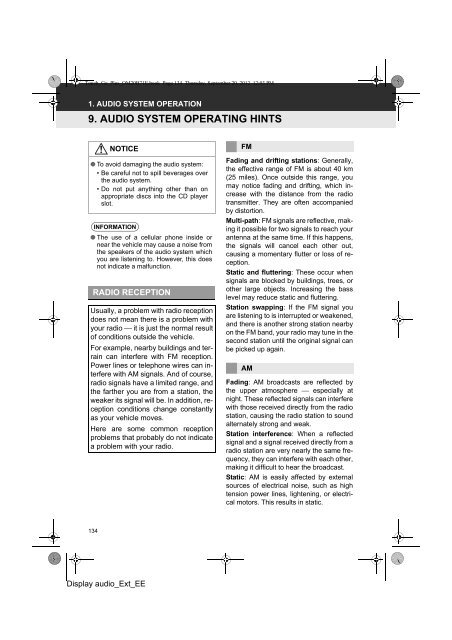Toyota Toyota Touch & Go - PZ490-00331-*0 - Toyota Touch & Go - Toyota Touch & Go Plus - English - mode d'emploi
Toyota Toyota Touch & Go - PZ490-00331-*0 - Toyota Touch & Go - Toyota Touch & Go Plus - English - mode d'emploi
Toyota Toyota Touch & Go - PZ490-00331-*0 - Toyota Touch & Go - Toyota Touch & Go Plus - English - mode d'emploi
You also want an ePaper? Increase the reach of your titles
YUMPU automatically turns print PDFs into web optimized ePapers that Google loves.
<strong>Touch</strong>_<strong>Go</strong>_<strong>Plus</strong>_OM20B71E.book Page 134 Thursday, September 20, 2012 12:03 PM<br />
1. AUDIO SYSTEM OPERATION<br />
9. AUDIO SYSTEM OPERATING HINTS<br />
NOTICE<br />
● To avoid damaging the audio system:<br />
• Be careful not to spill beverages over<br />
the audio system.<br />
• Do not put anything other than on<br />
appropriate discs into the CD player<br />
slot.<br />
INFORMATION<br />
● The use of a cellular phone inside or<br />
near the vehicle may cause a noise from<br />
the speakers of the audio system which<br />
you are listening to. However, this does<br />
not indicate a malfunction.<br />
RADIO RECEPTION<br />
Usually, a problem with radio reception<br />
does not mean there is a problem with<br />
your radio ⎯ it is just the normal result<br />
of conditions outside the vehicle.<br />
For ex<strong>amp</strong>le, nearby buildings and terrain<br />
can interfere with FM reception.<br />
Power lines or telephone wires can interfere<br />
with AM signals. And of course,<br />
radio signals have a limited range, and<br />
the farther you are from a station, the<br />
weaker its signal will be. In addition, reception<br />
conditions change constantly<br />
as your vehicle moves.<br />
Here are some common reception<br />
problems that probably do not indicate<br />
a problem with your radio.<br />
FM<br />
Fading and drifting stations: Generally,<br />
the effective range of FM is about 40 km<br />
(25 miles). Once outside this range, you<br />
may notice fading and drifting, which increase<br />
with the distance from the radio<br />
transmitter. They are often accompanied<br />
by distortion.<br />
Multi-path: FM signals are reflective, making<br />
it possible for two signals to reach your<br />
antenna at the same time. If this happens,<br />
the signals will cancel each other out,<br />
causing a momentary flutter or loss of reception.<br />
Static and fluttering: These occur when<br />
signals are blocked by buildings, trees, or<br />
other large objects. Increasing the bass<br />
level may reduce static and fluttering.<br />
Station swapping: If the FM signal you<br />
are listening to is interrupted or weakened,<br />
and there is another strong station nearby<br />
on the FM band, your radio may tune in the<br />
second station until the original signal can<br />
be picked up again.<br />
AM<br />
Fading: AM broadcasts are reflected by<br />
the upper atmosphere ⎯ especially at<br />
night. These reflected signals can interfere<br />
with those received directly from the radio<br />
station, causing the radio station to sound<br />
alternately strong and weak.<br />
Station interference: When a reflected<br />
signal and a signal received directly from a<br />
radio station are very nearly the same frequency,<br />
they can interfere with each other,<br />
making it difficult to hear the broadcast.<br />
Static: AM is easily affected by external<br />
sources of electrical noise, such as high<br />
tension power lines, lightening, or electrical<br />
motors. This results in static.<br />
134<br />
Display audio_Ext_EE
















